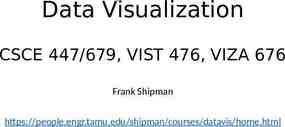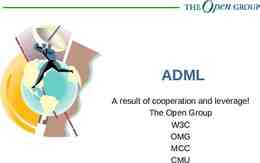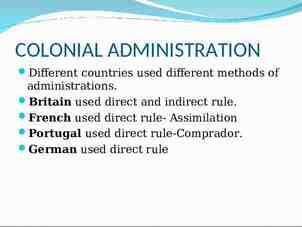Accounting Information Systems: An Overview Chapter 1 1
53 Slides233.00 KB

Accounting Information Systems: An Overview Chapter 1 1

Overview An accounting information system (AIS) is a collection of resources, such as people and equipment, designed to transform financial and other data into information. Accounting information systems perform this transformation whether they are essentially manual systems or thoroughly computerized. 2

Learning Objectives 1 Understand the related concepts of transaction cycles and internal control structure. 2 Describe the organizational structure of the information system function in organizations. 3

Learning Objectives 3 Discuss applications of information technology in organizations. 4 Characterize the development of information systems. 4

Learning Objective 1 Understand the related concepts of transaction cycles and internal control structure. 5

Information and Decisions Every organization accepts inputs and transforms them into outputs that take the form of products and services. Who are the two main users of accounting information? 1 External users 2 Internal users 6

Information and Decisions Who are the external users of accounting information? – stockholders – investors – creditors – government agencies – customers and vendors 7

Information and Decisions Who are the internal users of accounting information? – managers There are different information needs and demands at different managerial levels in an organization. 8

Information and Decisions Top-Level Management Middle Management Lower-Level Management Strategic Tactical Summarization and Filtration Operational Transaction Oriented 9

Information Systems The term information system suggests the use of computer technology in an organization. What is a computer-based information system? It is a collection of computer hardware and software designed to transform data into useful information. 10

Information Systems Electronic Data Processing System (EDP) Data Processing System (DP) Management Information System (MIS) Decision Support System (DSS) Expert System (ES) Executive Information System (EIS) Accounting Information System (AIS) 11

Business Processes A business process is an interrelated set of tasks that involve data, organizational units, and a logical time sequence. Business processes are always triggered by some economic event, and all have clearly defined starting and ending points. Most organizations experience similar types of economic events and activities. 12

Business Processes Primary Business Processes Inbound Inbound Sales Sales Logistics Logistics Outbound Outbound Sales Sales Logistics Logistics Operations Operations Marketing Marketing Service Service 13

Business Processes Supporting Business Processes Procurement Procurement Technology Technology Development Development Human Human Resources Resources Firm Firm Infrastructure Infrastructure 14

Transaction Processing Cycles Transaction cycles have traditionally grouped activities of a business into four common cycles of business activities. 1 Revenue cycle 2 Expenditure cycle 3 Production cycle 4 Finance cycle 15

Transaction Processing Cycles A fifth cycle is the financial reporting cycle. The financial reporting cycle is not an operating cycle. It obtains accounting and operating data from the other cycles and processes these data into financial reports. 16

Internal Control Process The internal control process is a process designed to provide reasonable assurance regarding the achievement of objectives in: – reliability of financial reporting – effectiveness and efficiency of operations – compliance with applicable laws and regulations 17

Internal Control Process What are the elements of internal control? – control environment – risk assessment – control activities – information and communication – monitoring 18

Internal Control Process How does the segregation of duties principle apply to the accounting function? No individual or department should control the accounting records relating to its own operation. What is internal auditing? It is an independent appraisal activity within the organization. 19

Learning Objective 2 Describe the organizational structure of the information system function in organizations. 20

The Information System Function The information system function is responsible for data processing. The information system function in organizations has evolved from simple organizational structures to complex structures involving many qualified specialists. 21

The Information System Function Chief Information Officer Manager Systems Analysis Manager Programming Manager Operations Steering Committee Manager Technical Support Manager User Support 22

The Information System Function Manager Systems Analysis Manager Programming Application Analysts Application Programmers 23

The Information System Function Manager Operations Maintenance Programmers File Librarian Data Entry Operators Computer Operators 24

The Information System Function Manager Technical Support Systems Programmers Communication Database Analysts Administration 25

The Information System Function A common variation of the functional form of organization is to structure the analysis and programming functions by project. In project organizations, analysts and programmers are assigned to specific application projects. 26

Learning Objective 3 Discuss applications of information technology in organizations. 27

End-User Computing End-user computing (EUC) is the hands-on use of computers by end users. Functional end users do their own information processing activities with hardware, software, and professional resources provided by the organization. 28

EUC: Mainframe Application Database Database Accounts AccountsReceivable Receivable Data Data User UserReport Report Query QueryLanguage Language Processor Processor User UserSubmits Submits Query QueryLanguage Language Job Job Database Database Access AccessControl Control Software Software 29

Data Processing for the End User Traditional Approach User Information System Specialists Data Processing 30

Data Processing for the End User End-User Approach User Database Software or Personal Computer Data Processing 31

Data Processing for the End User Personal computers (PCs) give end users their own processing power. Once users have obtained data, they may perform additional processing. 32

Quick-Response Technology Quick-response systems are essential to the total quality performance (TCP) movement in business. TQP is also called TQM or total quality management. It is a philosophy that one should do the right thing right the first time. TQP emphasizes customer satisfaction. 33

Quick-Response Technology Several technologies interact to make quick-response systems feasible. 1 Hardware and software standardization 2 Electronic data interchange (EDI) 3 Universal product code (UPC) bar code identification of products and scanning technologies 34

Quick-Response Technology Retailer’s Computer System Retail Retail Sale Sale of of Product Product Scan Scan Bar Bar Code Code Electronic Electronic Data Data Interchange Interchange Ship Ship Order Order Vendor’s Computer System 35

Web Commerce Sales via the World Wide Web are an integral part of the economy. What are some benefits? One benefit for consumers is that there is no waiting in line for a salesperson. One benefit for merchants is cost savings through automated ordering. 36

Electronic Data Interchange EDI is the direct computer-to-computer exchange of business documents via a communication network. What is the difference between EDI and email? Electronic mail involves messages created and interpreted by human. EDI involves messages between computers. 37

Electronic Data Interchange Retailer Eliminates Eliminates Paper Paper Purchase Order Supplier Saves Saves Time Time 38

Computer-Integrated Manufacturing Computer-integrated manufacturing (CIM) is an integrated approach to the use of information technology in manufacturing enterprises. CIM reduces information costs and, through EDI, brings the producer, the supplier, and the customer closer together. 39

Computer-Integrated Manufacturing What are the components of a CIM system? – computer-aided design (CAD) workstations – real-time production monitoring and control systems – order and inventory control system 40

Electronic Funds Transfer (EFT) Electronic funds transfer systems are payment systems in which processing and communication are primarily or totally electronic. Banks can interface with corporate EDI applications. 41

Learning Objective 4 Characterize the development of information systems. 42

The Accountant and Systems Development Accountants may undertake systems development activities either internally for their company or externally as consultants. Systems development activities are often encountered by internal and external auditors during reviews of information systems controls. 43

The Accountant and Systems Development A systems development project ordinarily consists of three general phases: – systems analysis – systems design – systems implementation 44

The Accountant and Systems Development Systems analysis involves formulating and evaluating solutions to systems problems. The emphasis is on the objectives of the entire system under consideration. Basic to this is an analysis of tradeoffs between system objectives. 45

The Accountant and Systems Development What are the general objectives of systems analysis? – to improve the quality of information – to improve internal control – to minimize cost, where appropriate 46

The Accountant and Systems Development Systems design is the process of specifying the details of the solution selected by the systems analysis process. It includes the evaluation of the relative effectiveness and efficiency of alternative system designs in light of the overall system requirements. 47

The Accountant and Systems Development Systems implementation is the process of placing the revised or newly designed procedures and methods into operations. It includes the following: – testing the solution prior to implementation – documenting the solution – reviewing the system 48

Systems Approach What is the systems approach? It is a general procedure for the administration of a systems project. Its purpose is to assist in the orderly development of effective systems. What are the six steps of the systems approach process? 49

Systems Approach 1 Statement of system objective(s) 2 Creation of alternatives 3 Systems analysis 4 Systems design 5 Systems implementation 6 Systems evaluation 50

Behavioral Considerations A new information system creates new work relationships among existing personnel. It creates changes in job content and perhaps a change in the formal organizational structure. Technical, behavioral, situational, and personnel factors should be considered. 51

Behavioral Considerations The user cooperation needed to operate the system successfully should be ensured during the design of a system, not afterward. A philosophy of user-oriented design fosters a set of attitudes and an approach to systems development that consciously considers the organizational context. 52

End of Chapter 1 53






